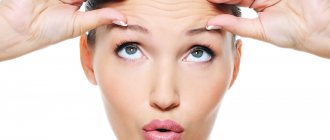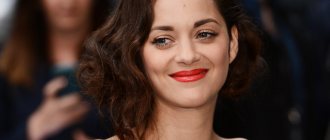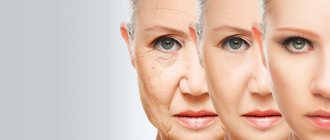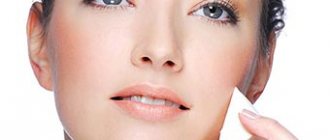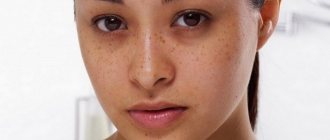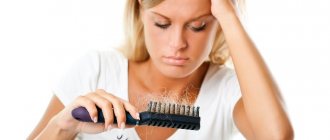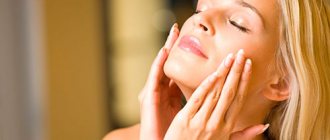The main goal of any surgical intervention in aesthetic surgery is the correction of defects that distort a person’s appearance, including age-related changes. The aging process on the face is clearly reflected, primarily in the eye area. Delicate and thin skin, easily susceptible to various factors, such as mechanical damage and age-related gravitational changes, begins to lose its properties quite early and succumb to various changes. Drooping of the eyelid crease is one of the earliest signs of this process. What methods of surgical modeling of the eyelid fold are used today - read on estet-portal.com.
Methods for correcting the palpebral fold of the eyelid
The relief of the upper eyelid has a special outline due to the upper orbital-palpebral groove and the fold of the eyelid, which is represented by two elements: overhanging and retracted skin duplications. This seemingly small structure is formed by many components: the skin of the eyelid, the orbicularis eyelid muscle, the levator muscle, layers of connective tissue, tarso-orbital fascia and orbital tissue.
The main detail that forms the eyelid fold is the fan of distal fibers of the levator aponeurosis, woven into the skin of the eyelid.
All this must be taken into account during surgical modeling of the palpebral fold of the eyelid.
Eyelid fold:
- features of the kinematics of the palpebral fold of the eyelid;
- mechanisms of changes in the palpebral fold of the eyelid;
- surgical modeling of the palpebral fold of the eyelid.
Will eyelid lifting at home really help?
- prepare masks strictly in accordance with the recipe and do not increase the concentration of ingredients yourself;
- use only freshly prepared mixtures; they cannot be stored even for 24 hours;
- use only natural and excellent quality ingredients;
- carry out eyelid care procedures daily, but be sure to take breaks (if recommended).
Pharmacy ointments and creams that “work” like lifting have a much greater effect. But it should be remembered that all of them are medicinal drugs and must be used in strict accordance with the instructions.
Features of the kinematics of the palpebral fold of the eyelid
Due to the dispersion of the aponeurosis fibers, which are woven into the skin, and the gradient distribution of forces on them, the fold of the eyelid responds well to the action of the levator, being pulled up and completely smoothed out when it relaxes. The palpebral fold of the eyelid reacts very actively to eye movements:
- if the gaze goes up, the fold of the eyelid deepens, lengthens, the eyelashes rise and the fold becomes clear;
- when looking down, the fold almost completely disappears and the eyelid becomes smooth;
- with an excited look, the palpebral fold is sharply expressed;
- with a dull look, the fold weakens and the eyelashes lower.
Mechanisms of changes in the palpebral fold of the eyelid
The anatomical structures present in the eyelid region participate to varying degrees in the formation of the palpebral fold.
The peculiarities of the formation of the fold depend on the constitution of the person, age-related changes in his body, injuries and diseases that affect the morphology.
The folded relief of the skin under the crease of the eyelid is caused by excess skin in the area of attachment of the distal fibers of the levator aponeurosis. A massive eyelid occurs as a result of hypertrophic development of the subcutaneous and suborbicular layers with thickening of loose connective tissue and interspersed with adipose tissue. If the patient has congenital or acquired levator paresis, due to the lack of force applied to the attachment site, the depth of the eyelid fold decreases. The fold is displaced downward by fatty hernias of the eyelids and hypertrophy of the orbital tissue.
Method No. 1: cover wrinkles with tapes
For men, wrinkles are considered a sign of maturity and wisdom. Women perceive wrinkles as a sign of aging. Reduced elasticity and the appearance of creases is a natural process. Wrinkles appear on the face, décolleté, even on the hands. Modern cosmetology works wonders; simple methods restore youth.
Botulinum toxin
Botulinum toxin is used to remove fine lines and wrinkles around the eyes or forehead. The drug is injected under the skin, interrupts the neuromuscular transition, and prevents muscle contraction. The effect lasts four months, the toxin gradually dissolves, and wrinkles return. The procedure does not contain contraindications; injections are used constantly.
Procedures like biorevitalization smooth out wrinkles using special fillers. Injections are used for wrinkles around the mouth, nose or décolleté. The procedure is selected individually during an in-person appointment. The exposure time depends on the chosen treatment method. It is advisable to use the latest generation drugs. The effect lasts from 6 months to 2 years. The procedure is safe.
Facial lipotransfer
Smoothing wrinkles using your own fat cells (lipotransfer). A new effective method that has revolutionized aesthetic medicine. For the procedure, fat is removed from the client's thigh or abdomen. It is enriched and injected into problem areas of the face, for example, upper, lower eyelids, nasolabial folds, chin, cheekbones. Medicine has not achieved 100% cell survival, at least 30% die, so the corrective procedure is repeated after six months.
The rejuvenation method (PRP) is based on the use of high levels of platelets in plasma (3-4 times higher than normal levels). Platelet-rich plasma is obtained from the patient's blood by repeated centrifugation. It is platelets that release growth factors into the surrounding tissues, act on cell membranes and trigger the rejuvenation process. The fraction is considered one of the most effective methods of cellular rejuvenation, second only to stem cell therapy. The PRP fraction is red.
Platelet-poor plasma is not concentrated enough to initiate rejuvenation at the cellular level, but it contains other beneficial substances that nourish and moisturize the epidermis. The PPP fraction is isolated from the patient's blood during the first centrifugation. The PPP fraction is yellow. The procedure has an immunostimulating effect due to which the skin is revitalized and looks younger.
Omnilux
The Omnilux hardware method is suitable for preventing the first signs of aging. Intense red light revitalizes collagen fibers and helps restore the epidermis. Unlike many other methods that show short-lived results, after therapy with the Omnilux device, the rejuvenating effect improves even after 5-6 months. At least 9 procedures will be required. Perform them weekly or once every two weeks. It can be used as an independent procedure or in combination.
Chemical peeling
Skin regeneration and rejuvenation is achieved by chemical peeling. Classic peeling based on glycolic acid helps achieve results comparable to surgical treatment.
Laser rejuvenation
Smoothbeam laser, the world's first FDA-approved laser for the treatment of wrinkles around the eyes. Thanks to the rays, fibroblasts are activated. After six weeks, new elastin and collagen fibers begin to be actively produced. The therapy is comfortable for the client, there are no side effects. It is simple and suitable for busy people. You can perform rejuvenation in this way during your lunch break or before going on a visit.
Facelift
The most radical surgical method removes wrinkles on the face and neck. The result of the operation will be a new, youthful appearance of the skin. A facelift is performed under anesthesia. The patient spends 1-2 days in the clinic, then 10-14 days at home for complete recovery.
Brow lift
An absolute novelty in plastic surgery is endoscopic brow lift. Helps correct the oval of the face, the position of the eyebrows, rejuvenate the eye area, and smooth out wrinkles on the forehead. The effect remains for a long time. Vertical expression lines or sagging eyelids cannot always be corrected using this method; sometimes additional help is required, for example, blepharoplasty. Before using eyebrow correction surgery, you must consult a doctor.
Instead of eyelid masks against wrinkles, you can use compresses; they are made using the following liquids:
- parsley juice - you can use both the root and the greens of the plant;
- decoction of chamomile flowers - take 150 ml of water per 1 tablespoon and cook for 3 minutes in a water bath;
- potato juice - prepared from fresh vegetables;
- black tea - make a “strong” brew;
- decoction of calendula flowers - prepared according to the same recipe as chamomile.
To perform the procedure, you need to soak cotton pads in the prepared liquid, squeeze them lightly and apply them to your eyes so that the upper eyelids, lower eyelids and, if possible, the area of the outer corners of the eyes are affected.
The photo shows an example of the correct application of the compress.
The compress duration is 10 minutes. There is no need to insulate it. After the procedure, wash with warm water and treat the skin with moisturizer.
For wrinkles on the eyelids, you can use other means/methods - professional creams-masks, patches, massage, gymnastics and resort to surgical intervention.
Cream mask for eyelids
| Description | Photo |
| Dizao | Smoothing, placental. Only natural ingredients were used in the production of the product. For the first 2 weeks, it is applied to the eyelids every day, then the manipulation is continued once a week - so-called “maintenance” therapy is carried out, which will consolidate the result. The mask is applied to previously cleansed skin and left there for 15 minutes, then washed off with warm water. This cosmetic product maximally moisturizes the skin, smoothes wrinkles and improves the overall tone of the dermis. |
| Mond Sub | A complex mask made of collagen and a bioactive complex with natural oils. It has a powerful moisturizing and smoothing effect, additionally whitens the skin and eliminates dark circles and excessive pigmentation. Available in the form of lobes, which are applied above and under the eyes for 30 minutes, they are removed by washing with warm water. This mask can be used a maximum of 3 times a week, there is no limitation on duration. |
| Skinlite "Collagen Eye Zone Mask" | Overhead masks, pack of 30 pieces. They are impregnated with a mixture of natural ingredients and plant extracts. They have a complex effect on the eyelids - rejuvenate, nourish, improve tone, and moisturize. Can be used 2-3 times a week, the first results will be noticeable after 3-5 uses. |
The massage can and should be performed every day; both the upper eyelid and the area under the eyes are affected. Be sure to use cosmetic oils or moisturizer during the manipulation - this will ensure the correct procedure.
Massage involves performing only two movements:
- precisely massage the upper eyelid with your fingertips, while simultaneously pulling it up;
- rub the eyelid with your middle and index fingers, “pulling” it towards your temples.
First, the massage is done on the upper eyelid, then the area under the eyes is treated. The total time of the manipulation is 10 minutes. After it, you need to wash your face with warm water and lubricate your skin with your usual moisturizer.
Eyelid massage points
As for special exercises to improve the tone of the eyelid skin and tighten the upper eyelid, you need to perform the following complex:
- Close your eyes as tightly as possible. Sharply open your eyes and perform 2-3 movements with your eyeballs to the sides and up/down.
- Raise your eyebrows as high as possible and close your eyes. After 3 seconds, open them and only after that return the eyebrows to the “original” position.
- Using your fingers, pull your eyebrows as high as possible and slightly to the sides. Blink your eyes quickly for 5-10 seconds.
Each exercise should be repeated 3-5 times. It is advisable to do this exercise in the morning, before applying makeup. In the evening, you should give preference to massage and masks.
You can quickly and most effectively get rid of sagging upper eyelids only through surgical intervention, but when agreeing to a lift, you need to take into account the following nuances of such manipulation:
- this is a full-fledged operation that is performed under general anesthesia and requires mandatory hospitalization of the patient;
- This service is very expensive and belongs to the category of plastic surgery;
- the postoperative period requires the use of supportive, antibacterial therapy;
- full recovery after surgery can occur only after 7 weeks (and this is if there are no complications);
- Scars and scars may form at the site of the operation.
To solve these age-related problems, doctors use the following types of surgical lifting:
- Upper blepharoplasty. During the work, the surgeon removes excess fatty tissue and excess skin (stretched). At the same time, the elasticity of the muscles in the eye area is corrected. The entire procedure lasts 50-60 minutes and is performed under general anesthesia, but in some cases local anesthesia is used.
Upper blepharoplasty
The cost of upper blepharoplasty ranges from 40-50 thousand rubles.
- Transconjunctival blepharoplasty. Removal of fatty tissue is carried out through an incision in the mucous membrane of the lower eyelid. If necessary, the doctor makes incisions in the subciliary space of the upper eyelid. It is considered a more complex operation, lasts 1-1.5 hours, and requires a long rehabilitation period.
Transconjunctival blepharoplasty
The price of such surgical intervention ranges from 60 thousand rubles.
- Mini-lifting. Incisions are made in the temple area and near the ears. “Excess” skin is cut out with a narrow strip, after which not only the eyelids, but also their outer corners are tightened. The operation lasts 2-3 hours, is performed only under general anesthesia, rehabilitation lasts at least 30 days.
The price of a mini eye lift is about 80 thousand rubles.
You can try another effective method at home - taping. Special patches made of cotton fabric (kinesio tapes) are glued to problem areas of the face strictly along the massage lines for 2-3 hours (no more!). Tapes lift the skin above the muscles, blood begins to circulate better, and the muscles relax at this time. This way, excess water comes out and the rays around the eyes are smoothed out.
Surgical modeling of the palpebral fold of the eyelid
Each stage of surgical modeling of the palpebral fold of the eyelid has its own important features:
- making a cut: it is most convenient to make a cut along the line of the intended fold;
- skin: skin resection is performed if there is an excess of it and a free flap is transplanted if there is a deficiency;
- layers of loose connective tissue: the excess layer in front and behind the orbicularis muscle makes the palpebral fold heavier, so it needs to be thinned. The lack of a loose layer is compensated with the help of fillers or orbital fiber;
- orbicularis muscle: resected in cases where there is excess thickness and area, decreased tone, or absence of high fibers of the levator aponeurosis intertwined into the skin. The resection area should be above the crease line;
- levator aponeurosis: to reduce the high fold, its upper fibers are cut, to form a high fold, the tarso-orbital fascia is cut off from the aponeurosis, and the fold is fixed at the desired height;
- fixation of the eyelid fold is the main element of surgical intervention. In the standard version, dermal-aponeurotic fixation is performed with U-shaped sutures through the mobilized orbicularis muscle. If necessary, suturing is supplemented with deep fixation and an increase in the number of sutures.
Share:

